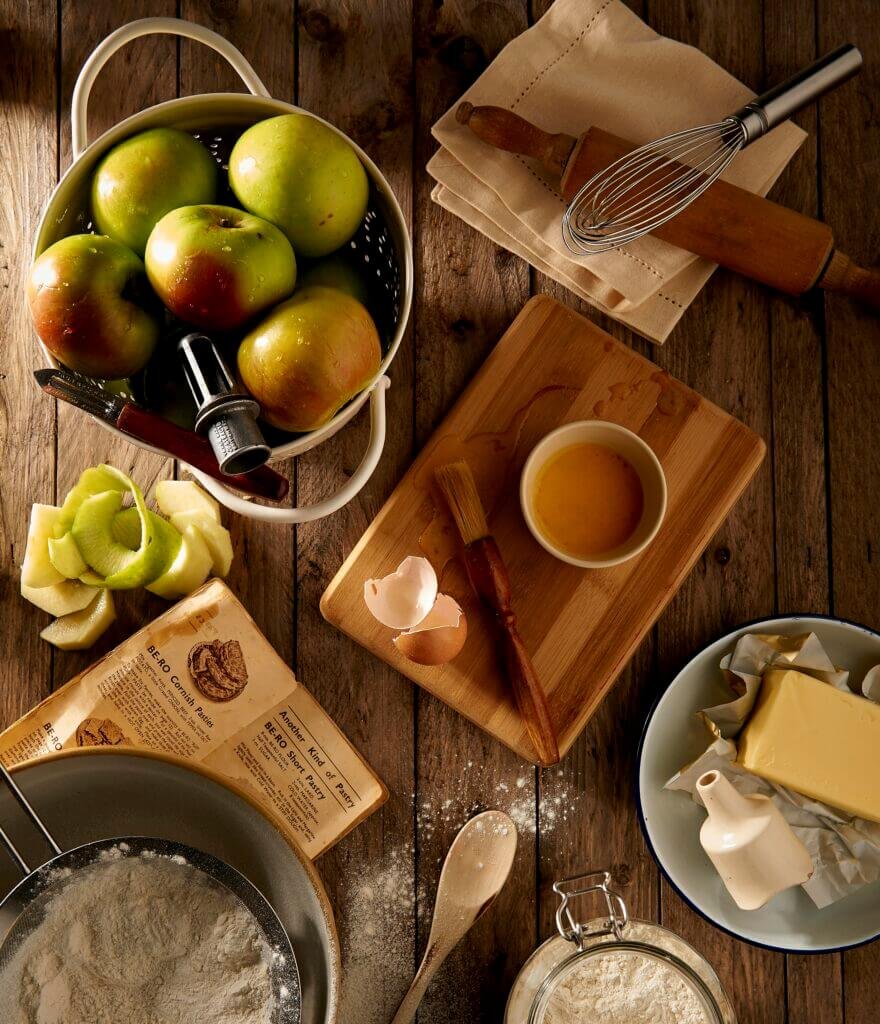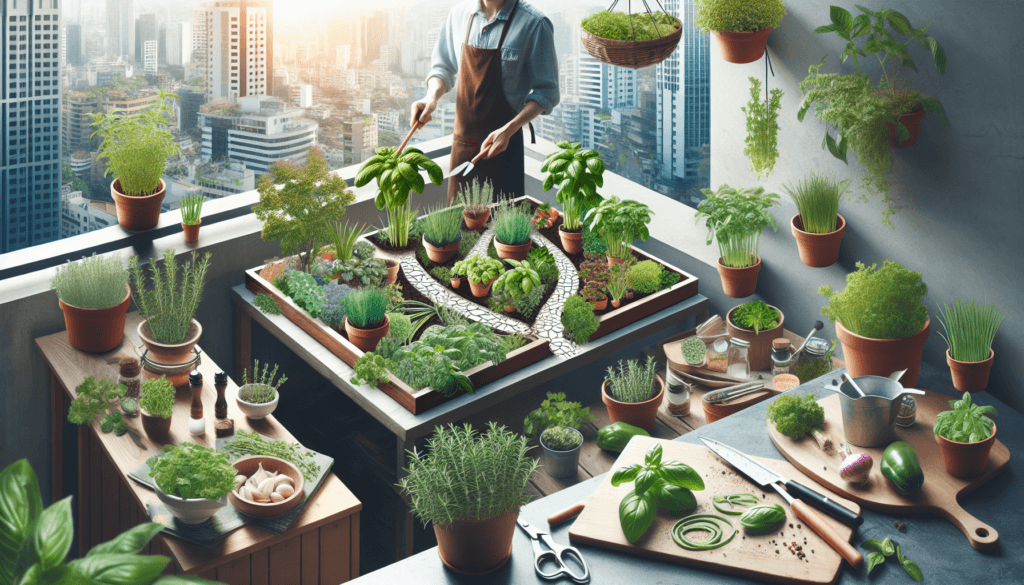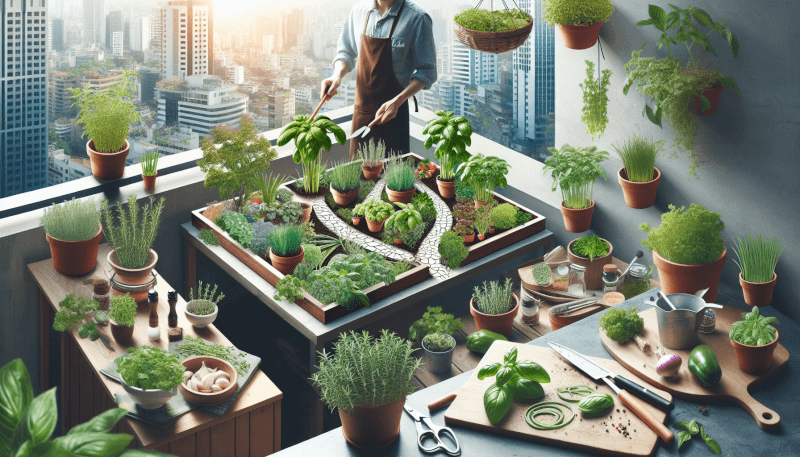Urban gardening has taken off in recent years, providing city dwellers with a way to connect with nature and enjoy fresh produce right at their doorstep. Whether you have a spacious backyard or a tiny balcony, growing herbs in an urban garden is a rewarding and practical endeavor. From the aromatic basil to the versatile rosemary, this article explores the most popular herbs to grow in an urban garden. Discover their benefits, growing tips, and how to incorporate them into your culinary creations. Get ready to elevate your urban gardening game and bring a burst of flavor to your meals.

Basil
Overview
Basil is an aromatic herb that is widely loved for its distinctive taste and fragrance. It is a member of the mint family and is popularly used in various cuisines around the world. Basil plants are relatively easy to grow and can be a rewarding addition to any urban garden.
Varieties
There are several varieties of basil available, each with its unique characteristics. Some popular varieties include sweet basil, lemon basil, Thai basil, and purple basil. Sweet basil is the most commonly grown variety and is known for its rich and sweet flavor.
Growing Tips
To grow basil successfully, you will need a sunny spot in your urban garden. Basil plants require at least six hours of direct sunlight per day. They also prefer well-draining soil that is kept consistently moist but not waterlogged. It is best to start basil seeds indoors and transplant them outside once the threat of frost has passed.
Harvesting
You can start harvesting basil leaves once the plant has grown to a decent size. It is recommended to pinch off the leaves regularly to encourage bushier growth. When harvesting, choose healthy leaves from the top of the plant, as they tend to have the best flavor. Avoid picking all the leaves at once, as the plant needs some foliage to continue growing.
Uses
Basil is a versatile herb that has many culinary uses. It is most commonly used fresh in salads, pasta sauces, pesto, and Caprese salads. It can also be dried or frozen for later use. Apart from its culinary applications, basil is also used in traditional medicine and aromatherapy due to its potential health benefits.
Mint
Overview
Mint is a refreshing and aromatic herb that is known for its cooling sensation and distinctive flavor. It is incredibly adaptable and can thrive in various growing conditions, making it a popular choice for urban gardeners. Mint’s versatility makes it an excellent addition to any herb garden.
Varieties
There are numerous varieties of mint available, each with its unique flavor and scent. Some common varieties include peppermint, spearmint, chocolate mint, and pineapple mint. Peppermint has a strong menthol flavor, while spearmint has a milder and sweeter taste.
Growing Tips
Mint is a fast-growing herb that can spread quickly, so it is advisable to grow it in containers or isolated areas to prevent it from taking over the garden. It thrives in partial shade or full sun but may struggle in intense heat. Mint prefers moist soil, so make sure to water it regularly.
Harvesting
You can start harvesting mint leaves once the plant has become established. To harvest, pinch off the leaves just above a set of healthy leaves, taking care not to damage the stem. Frequent harvesting will encourage bushier growth and ensure a fresh supply of mint leaves throughout the growing season.
Uses
Mint is widely used in both savory and sweet dishes, providing a refreshing and cooling flavor. It is commonly used in beverages like mojitos, mint juleps, and herbal teas. Mint leaves can also be added to salads, sauces, desserts, and even homemade ice cream. Additionally, mint is known for its medicinal properties and is often used to relieve digestive issues and freshen breath.

Rosemary
Overview
Rosemary is an evergreen herb that is well-known for its fragrant needles and distinctive flavor. It is a versatile herb that can thrive in urban gardens, adding both flavor and aroma to various dishes. Rosemary plants are beautiful additions to any garden, with their needle-like leaves and delicate blue flowers.
Varieties
There are several varieties of rosemary available, including common rosemary, Tuscan blue rosemary, and trailing rosemary. Common rosemary is the most widely grown variety, known for its strong flavor and growth habit. Tuscan blue rosemary has a milder taste and vibrant blue flowers, while trailing rosemary is perfect for cascading over the edges of containers or hanging baskets.
Growing Tips
Rosemary requires a sunny spot in your urban garden, as it thrives in full sun. It prefers well-draining soil, as it can be sensitive to excessive moisture. Rosemary plants are drought-tolerant once established but need regular watering during the first year. Pruning rosemary regularly will help maintain its shape and encourage bushier growth.
Harvesting
You can start harvesting rosemary sprigs once the plant has grown to a suitable size. It is best to harvest early in the day when the essential oils are most concentrated. Pinch off sprigs from the top of the plant, leaving enough foliage to sustain growth. Use fresh rosemary in your recipes, or hang the sprigs to dry for later use.
Uses
Rosemary is a versatile herb that adds a bold and aromatic flavor to many dishes. It is commonly used in Mediterranean cuisine, including roasted meats, soups, stews, and bread. You can also infuse rosemary into oils and vinegars, creating flavorful dressings and marinades. Additionally, rosemary’s strong scent makes it a popular ingredient in beauty products and natural remedies.
Thyme
Overview
Thyme is a fragrant and flavorful herb that is widely used in cooking and herbal medicine. It is a hardy perennial herb that can thrive in urban gardens, providing a steady supply of fresh thyme leaves throughout the year. Thyme plants are attractive with their small, delicate leaves and clusters of tiny flowers.
Varieties
There are several varieties of thyme available, each with its unique flavor and appearance. Common thyme, lemon thyme, and French thyme are some popular varieties. Common thyme has a slightly peppery flavor, lemon thyme adds a citrusy note, and French thyme is known for its mild taste.
Growing Tips
Thyme is a low-maintenance herb that can tolerate a variety of growing conditions. It prefers a sunny spot with well-draining soil. Thyme plants are drought-tolerant once established and do not require frequent watering. Regular pruning will help maintain the plant’s shape and encourage new growth.
Harvesting
You can start harvesting thyme leaves once the plant has reached a suitable size. To harvest, pinch off individual leaves or cut entire stems just above a set of leaves. Thyme leaves can be used fresh or dried for later use. Drying thyme is simple – hang the stems upside down in a well-ventilated area until the leaves are completely dry.
Uses
Thyme is used in various cuisines worldwide for its distinct flavor and aroma. It is a common ingredient in stews, roasted meats, and vegetable dishes. Thyme can also be added to marinades, stocks, and sauces. Additionally, thyme has antimicrobial properties and is often used in natural remedies for respiratory issues and sore throats.

Parsley
Overview
Parsley is a versatile and widely used herb that is a staple in many culinary traditions. It is a biennial herb that is grown as an annual in most gardens. Parsley plants are attractive with their vibrant green leaves and delicate texture, making them a great addition to any urban garden.
Varieties
There are two widely grown varieties of parsley: curly parsley and flat-leaf (Italian) parsley. Curly parsley has tightly curled leaves and is often used as a garnish. Flat-leaf parsley has a stronger flavor and is preferred for cooking. Both varieties can be grown in an urban garden with ease.
Growing Tips
Parsley is a relatively easy herb to grow and can tolerate a range of growing conditions. It thrives in partial shade or full sun and prefers well-draining soil. Parsley plants need consistent moisture, so regular watering is essential. Starting parsley plants from seeds is relatively straightforward and can be done indoors before transplanting them outside.
Harvesting
You can start harvesting parsley leaves once the plant has some healthy growth. Harvesting parsley is as simple as snipping off individual stems or leaves as needed. Avoid stripping all the leaves at once, as the plant needs foliage to continue growing. Fresh parsley leaves can be used immediately, while excess leaves can be dried or frozen for later use.
Uses
Parsley is a versatile herb that is commonly used as a garnish and flavor enhancer in various dishes. It adds a fresh and vibrant element to salads, soups, sauces, and marinades. Parsley pairs well with other herbs and spices, making it a popular ingredient in herb blends. Additionally, parsley is known for its nutritional value, containing high levels of vitamins A, C, and K.
Chives
Overview
Chives are a flavorful and onion-like herb that is often used as a culinary topping or garnish. They are easy to grow and can thrive in urban gardens, providing a fresh supply of chive leaves throughout the growing season. Chives plants are attractive with their slender, hollow leaves and spherical pink flowers.
Varieties
The most common variety of chives is the common chives, also known as onion chives. There are also garlic chives, which have a milder and more garlicky flavor. Both varieties can be grown in an urban garden, but common chives are more widely available.
Growing Tips
Chives can be grown in a variety of soil types, but they prefer well-draining soil that is rich in organic matter. They can tolerate partial shade but thrive in full sun. Chives need consistent moisture, so regular watering is essential. Starting chive plants from seeds or dividing existing plants is the most common method of propagation.
Harvesting
You can start harvesting chive leaves once the plant has established itself. To harvest, snip the leaves as close to the base as possible. Avoid cutting too many leaves at once, as the plant needs some foliage to continue growing. Chives can be harvested throughout the growing season and used fresh or frozen for later use.
Uses
Chives are often used as a garnish or topping due to their mild onion flavor and vibrant green color. They can be added to salads, soups, omelets, and various dishes for a pop of freshness. Chives are also commonly used in herb butter, cream cheese, and dips. Additionally, their edible flowers can be used to add color and flavor to dishes.

Cilantro
Overview
Cilantro, also known as coriander, is an herb with a distinctive flavor that is widely used in many cuisines around the world. It is a fast-growing herb that can be grown in urban gardens with ease. Cilantro plants are attractive with their delicate, lacy leaves and small white flowers.
Varieties
There is only one main variety of cilantro, commonly known as Mexican cilantro or Chinese parsley. However, cilantro seeds can be harvested and ground into coriander, which is a popular spice with its own unique flavor.
Growing Tips
Cilantro prefers cooler temperatures and can bolt quickly in hot weather, so it is best to grow it in the spring or fall. It requires well-draining soil and at least six hours of sun per day. Cilantro plants need consistent moisture, but overwatering can lead to root rot. Starting cilantro from seeds directly in the garden is the most common method of propagation.
Harvesting
You can start harvesting cilantro leaves once the plant has grown to a suitable size. Harvesting can be done by snipping off individual leaves or cutting entire stems from the base of the plant. Cilantro leaves have the best flavor when used fresh, so it is recommended to use them immediately. However, excess leaves can be stored in the refrigerator or dried for later use.
Uses
Cilantro is widely used in various cuisines, particularly in Mexican, Indian, and Southeast Asian dishes. The leaves have a distinctive and vibrant flavor that adds freshness to salsas, curries, salads, and guacamole. Additionally, cilantro stems and roots are popular ingredients in many Asian recipes. Coriander seeds, obtained from mature cilantro plants, are used as a spice in pickling, baking, and savory dishes.
Dill
Overview
Dill is an aromatic herb with a unique flavor that is often associated with pickles and seafood dishes. It is an easy-to-grow herb that can be grown in urban gardens, providing a fresh supply of dill leaves and seeds. Dill plants have feathery leaves and produce large, umbrella-shaped flower heads.
Varieties
There are several varieties of dill available, including Fernleaf dill, Bouquet dill, and Mammoth dill. Fernleaf dill is a compact variety that is ideal for small gardens or containers. Bouquet dill is a popular variety that is known for its flavorful leaves and seeds. Mammoth dill is the largest variety, often reaching heights of three to five feet.
Growing Tips
Dill plants prefer full sun but can tolerate some shade. They require well-draining soil and regular watering to prevent the soil from drying out. It is best to directly sow dill seeds into the garden as they do not transplant well. However, you can start seeds indoors and transplant them carefully if necessary.
Harvesting
You can start harvesting dill leaves once the plant has reached a suitable size. To harvest, snip off the leaves as close to the stem as possible. The young leaves have the best flavor, so it is recommended to harvest them before the plant starts flowering. Dill seeds can be harvested once the flowers have dried and turned brown.
Uses
Dill is widely used in pickling, adding its distinctive flavor to cucumbers, beets, and other vegetables. It is also a popular herb in seafood dishes, enhancing the taste of fish, shrimp, and salmon. Dill leaves can be used fresh in salads, soups, stews, and sauces. Dill seeds are often used in baking, particularly in bread and pastry recipes. Additionally, dill is known for its digestive benefits and is commonly used in herbal remedies for soothing stomach discomfort.

Oregano
Overview
Oregano is a flavorful herb that is often associated with Mediterranean cuisine. It is a perennial herb that can be grown in urban gardens, providing a fresh supply of oregano leaves throughout the year. Oregano plants have small, oval-shaped leaves and produce clusters of small white or pink flowers.
Varieties
There are several varieties of oregano available, including Greek oregano, Italian oregano, and Mexican oregano. Greek oregano is the most commonly grown variety, known for its robust and earthy flavor. Italian oregano has a milder taste and is frequently used in pasta sauces and pizzas. Mexican oregano has a citrusy undertone and is popular in Tex-Mex and Latin American cuisines.
Growing Tips
Oregano plants thrive in full sun but can tolerate partial shade. They prefer well-draining soil and, once established, can tolerate drought. Oregano is a hardy herb that does not require much maintenance. Regular pruning will help maintain the shape of the plant and encourage bushier growth.
Harvesting
You can start harvesting oregano leaves once the plant has become established. To harvest, snip off individual leaves or cut entire stems just above a set of leaves. Oregano leaves can be used fresh or dried for later use. To dry oregano, bundle a few stems together and hang them upside down in a well-ventilated area until the leaves are crisp.
Uses
Oregano is a versatile herb that is commonly used in Mediterranean dishes. It adds a savory and slightly bitter flavor to pasta sauces, pizza, roasted vegetables, and marinades. Oregano can also be infused into oils or vinegars, providing a fragrant base for dressings and marinades. Additionally, oregano has antibacterial properties and is used in traditional medicine to alleviate digestive issues and fight off infections.
Cilantro
Overview
Cilantro, also known as coriander, is an herb with a distinctive flavor that is widely used in many cuisines around the world. It is a fast-growing herb that can be grown in urban gardens with ease. Cilantro plants are attractive with their delicate, lacy leaves and small white flowers.
Varieties
There is only one main variety of cilantro, commonly known as Mexican cilantro or Chinese parsley. However, cilantro seeds can be harvested and ground into coriander, which is a popular spice with its own unique flavor.
Growing Tips
Cilantro prefers cooler temperatures and can bolt quickly in hot weather, so it is best to grow it in the spring or fall. It requires well-draining soil and at least six hours of sun per day. Cilantro plants need consistent moisture, but overwatering can lead to root rot. Starting cilantro from seeds directly in the garden is the most common method of propagation.
Harvesting
You can start harvesting cilantro leaves once the plant has grown to a suitable size. Harvesting can be done by snipping off individual leaves or cutting entire stems from the base of the plant. Cilantro leaves have the best flavor when used fresh, so it is recommended to use them immediately. However, excess leaves can be stored in the refrigerator or dried for later use.
Uses
Cilantro is widely used in various cuisines, particularly in Mexican, Indian, and Southeast Asian dishes. The leaves have a distinctive and vibrant flavor that adds freshness to salsas, curries, salads, and guacamole. Additionally, cilantro stems and roots are popular ingredients in many Asian recipes. Coriander seeds, obtained from mature cilantro plants, are used as a spice in pickling, baking, and savory dishes.


